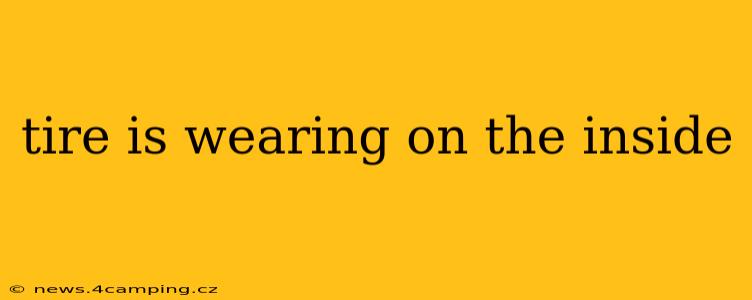Uneven tire wear, particularly on the inside edges, is a common problem that can significantly impact your vehicle's handling, fuel efficiency, and safety. This article will delve into the various reasons why your tires might be wearing on the inside, helping you diagnose the issue and find the right solution. Understanding the root cause is crucial for preventing further damage and ensuring a safe driving experience.
Why is the Inside of My Tires Wearing Out?
Internal tire wear is rarely caused by a single factor. Instead, it's usually a combination of issues that need to be addressed comprehensively. Let's explore some of the most common culprits:
1. Misalignment:
This is often the primary cause of inside tire wear. When your wheels aren't properly aligned, they don't track straight, causing the tires to scrub against the road surface at an angle. This increased friction leads to accelerated wear on the inside edges. There are three main types of misalignment:
- Toe: This refers to the angle of the wheels as viewed from the front. Toe-in (wheels angled slightly inward) is more likely to cause inside tire wear.
- Camber: This is the angle of the wheels relative to the vertical axis. Negative camber (wheels tilted inward at the top) can exacerbate inside wear.
- Caster: This affects the steering responsiveness and can indirectly influence tire wear patterns.
Regular wheel alignments are essential for preventing premature tire wear and maintaining optimal handling.
2. Suspension Problems:
Damaged or worn suspension components, such as ball joints, tie rod ends, control arm bushings, or shock absorbers, can impact wheel alignment and contribute to uneven tire wear. A faulty suspension system can lead to excessive wheel movement, causing the tires to scrub against the road surface in an unnatural way.
3. Worn Shocks or Struts:
These components dampen the bounce and sway of your vehicle. Worn shocks or struts allow for excessive bouncing and movement, leading to irregular tire contact with the road and increased inside wear.
4. Incorrect Tire Pressure:
Underinflated tires increase the contact patch, particularly on the inside edges, leading to more wear in that area. Conversely, overinflation can cause excessive wear on the center of the tire. Always maintain the recommended tire pressure specified in your vehicle's owner's manual or on the tire sidewall.
5. Vehicle Load:
Overloading your vehicle can put extra strain on the suspension and tires, contributing to increased inside tire wear. Ensure that you don't exceed the vehicle's maximum load capacity.
What Should I Do if My Tires are Wearing on the Inside?
If you notice inside tire wear, it's crucial to address the issue promptly. Here's what you should do:
- Check your tire pressure: Ensure it matches the recommended levels.
- Have a wheel alignment performed: This is the most common solution. A qualified mechanic can identify and correct any misalignment issues.
- Inspect your suspension system: Look for any signs of damage or wear and have any faulty components replaced.
- Replace worn shocks or struts: This will restore proper suspension function and prevent further tire wear.
- Avoid overloading your vehicle: Adhere to the manufacturer's recommended load capacity.
How Often Should I Get a Wheel Alignment?
The frequency of wheel alignments depends on various factors, including driving habits, road conditions, and vehicle type. However, it's generally recommended to have your wheels aligned at least once a year, or more frequently if you notice any signs of uneven tire wear, such as inside wear.
Can I Fix Inside Tire Wear Myself?
While you can check your tire pressure and visually inspect your suspension, fixing misalignment or replacing suspension components requires specialized tools and expertise. It's best to consult a qualified mechanic or tire professional for diagnosis and repair.
By addressing the root cause of inside tire wear, you can prolong the life of your tires, improve your vehicle's handling, and enhance your overall safety. Remember, regular maintenance is key to preventing costly repairs and ensuring a smooth, reliable driving experience.
